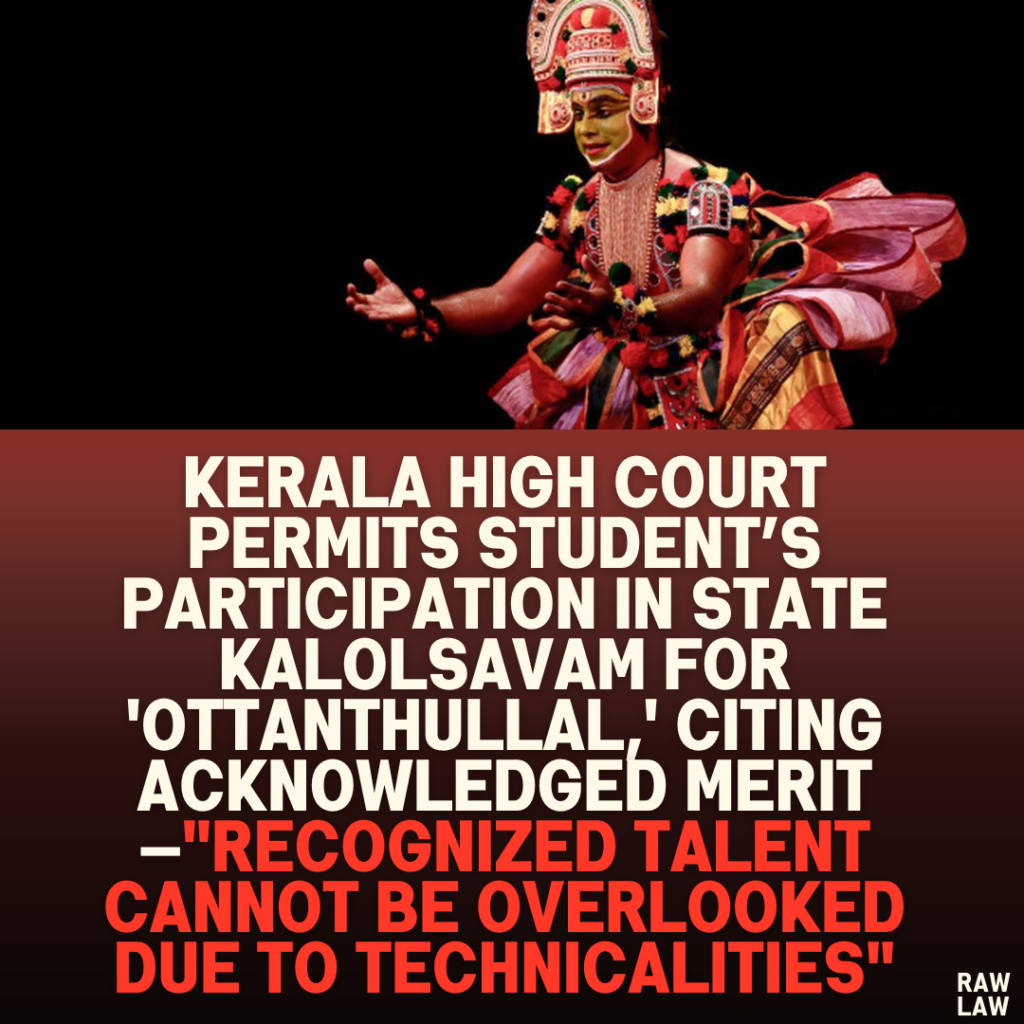Court’s Decision
The Kerala High Court, through a judgment delivered by Justice C. Jayachandran, directed the concerned authorities to allow the petitioner to participate in the State Kalolsavam for the event ‘Ottanthullal (Girls).’ This relief was granted based on the specific findings in Ext.P3, which recognized the petitioner’s excellent performance and abilities. The Court emphasized that her inclusion would depend on verifying that the code number 273 pertains to her, ensuring due procedural compliance while prioritizing merit.
Facts
- Background of the Competition: The petitioner, a 12th-standard student from Thiruvananthapuram, participated in the ‘Ottanthullal (Girls)’ event in the Revenue District School Kalolsavam. Despite her excellent performance, she secured only the second position.
- Petitioner’s Appeal: Dissatisfied with the result, the petitioner appealed to the competition’s appeal committee. The committee acknowledged her performance as excellent and recognized her abilities but dismissed the appeal due to:
- Time constraints.
- The large number of contestants.
- Challenged Decision: The petitioner approached the High Court, seeking judicial intervention to participate in the subsequent State Kalolsavam, arguing that the dismissal of her appeal on procedural grounds was arbitrary.
- Key Document (Ext.P3): Ext.P3, the appeal committee’s report, specifically mentioned the petitioner’s performance and abilities as commendable, adding weight to her case.
Issues
The Court examined the following key issues:
- Merit vs. Procedural Constraints: Whether procedural limitations, such as time constraints, can justify the exclusion of a candidate whose merit is explicitly recognized.
- Identification via Code Number: Whether the petitioner could be linked to the code number 273, which would validate her claim for participation.
- Fairness in Administrative Decisions: Whether the appeal committee’s dismissal of the petitioner’s claim, despite recognizing her abilities, was fair and reasonable.
Petitioner’s Arguments
- Merit Recognition: The petitioner argued that her performance in the event was exceptional and deserved recognition, as confirmed by the appeal committee in Ext.P3.
- Unjust Exclusion: She contended that the dismissal of her appeal based on procedural reasons such as time constraints and the number of contestants was arbitrary and overlooked her abilities.
- Relief Sought: The petitioner sought the Court’s intervention to ensure her inclusion in the State Kalolsavam based on her acknowledged talent and performance.
Respondent’s Arguments
- Procedural Validity: The Government Pleader opposed the petitioner’s claim, emphasizing that there was no conclusive evidence linking the petitioner to the code number 273.
- Evaluation Process: It was highlighted that the difference in marks between the first and second positions was minimal—only three marks—and this distinction justified the original decision.
- Adherence to Guidelines: The respondents defended the decision as being in line with the procedural and evaluation guidelines for the competition.
Analysis of the Law
The Court undertook a detailed analysis of the following legal and administrative aspects:
- Merit-Based Decisions: It reiterated the principle that merit should take precedence in situations involving administrative decisions, particularly in cultural and educational competitions.
- Procedural vs. Substantive Justice: The Court emphasized that procedural constraints, such as limited time or a high number of contestants, cannot override substantive justice, especially when merit is clearly established.
- Evidence of Performance: The Court relied heavily on Ext.P3, which unequivocally acknowledged the petitioner’s excellent performance and abilities. This report served as a critical piece of evidence in the petitioner’s favor.
Precedent Analysis
No specific legal precedents were explicitly cited in this case. However, the judgment aligns with established principles of administrative law, which prioritize fairness, justice, and merit in decision-making processes.
Court’s Reasoning
The Court based its decision on the following reasoning:
- Merit Recognized in Ext.P3: The Court placed significant reliance on Ext.P3, which explicitly commended the petitioner’s performance and abilities.
- Unjust Dismissal of Appeal: It found the dismissal of the appeal on the grounds of time constraints and the number of contestants insufficient and unjustified, as these factors did not relate to the petitioner’s merit.
- Verification of Code Number 273: To address the procedural objections raised by the respondents, the Court directed the authorities to verify whether code number 273 pertained to the petitioner. This ensured that the decision was procedurally compliant without disregarding the substantive merit of the case.
Conclusion
The High Court allowed the writ petition and directed the respondents to permit the petitioner to participate in the State Kalolsavam for the event ‘Ottanthullal (Girls),’ subject to verifying her eligibility as per the code number 273. The judgment highlighted the importance of prioritizing talent and merit over procedural technicalities in administrative decisions.
Implications
- Merit Over Procedural Constraints: This judgment reinforces the principle that procedural limitations, such as time constraints, cannot outweigh merit-based decisions in educational and cultural contexts.
- Fairness in Administrative Decisions: It underscores the need for fairness and justice in decision-making processes, ensuring that talent and performance are recognized appropriately.
- Precedent for Similar Cases: The judgment sets a precedent for future cases involving merit-based challenges in school or cultural competitions, emphasizing the importance of substantive justice.




Pingback: Delhi High Court Dismisses Challenge to DJS Mains 2023 Evaluation: “Judicial Review Not a Substitute for Re-Evaluation; Answer-Key and Shortlisting Process Cannot Be Interfered With Unless Palpably Incorrect” - Raw Law